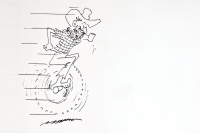Archived Outdoors
Ornithologist unravels mysteries behind song sparrow personalities
Last Thursday morning was atypical for song sparrow IR-IF. While defending his territory from the song of an intruding male, he landed in the net of Jeremy Hyman, a biology professor at Western Carolina University.
Held tightly in Hyman’s hand, IR-IF got a set of ankle bands. Hyman measured the bird’s wing length, tarsus and beak before putting him in a white bag to weigh him.
Hyman released the bird from his grip, and IR-IF flew to a nearby bush to pick at his new bands with his beak.
“He’ll be back to defending his territory in no time,” Hyman said.
IR-IF is king of the small garden and shrubs by a courtyard on campus and is one of the most aggressive males at WCU. IR-IF’s territory is one of more than 100 on the campus.
Hyman studies 40 of the territories. He researches the behaviors of song sparrows and compares the urbanized population around the campus to other areas. Hyman has loved bird watching since he was a kid and learned the art of birding from his grandpa in New York City.
“I didn’t know it could turn into a profession,” he said.
He earned his bachelor’s degree in biology from the University of Chicago in 1993 and remembers awkwardly trapping his first bird, a Carolina wren, as a senior.
“I quickly learned the hang of it though,” he said.
He started teaching at Western four years ago and is once again spending the summer studying local bird populations on campus.
“I immediately saw these birds were way more aggressive than the ones I’d known before,” said Hyman, who studied the same species of sparrow extensively in Pennsylvania.
Hyman measures how aggressive the birds are through playback experiments. He goes into a male’s territory and sets up a small speaker. The speaker plays the song of another male from his field studies in Pennsylvania.
Each male has a repertoire of about five to 13 songs. During mating season, roughly March to September, they sing the songs to attract females and hold their turf.
Aggressive males will swoop down and chip lower pitched songs at the speaker. Hyman tracks how close the males get to the speaker and how many songs they sing during the experiment.
To make sure the difference is truly between urban and rural populations instead of just between North Carolina and Pennsylvania sparrows, Hyman has done playback experiments at Purchase Knob, a remote area of the Great Smoky Mountains National Park in Haywood County where the birds encounter few people.
While Hyman has detected broad trends in the aggressiveness of rural versus urban populations, personalities vary between individual birds — just like they would within a group of people. For example, not all male song sparrows have the boisterous personality of IR-IF.
“You also have these birds that are real wimps year after year,” Hyman said.
He recalled one bird from Pennsylvania that would live in the same territory for six or seven years. Every time Hyman would play a foreign bird’s song, the sparrow would fly off in the opposite direction and hide in the bushes.
“How are both those things coexisting in a population?” Hyman said.
Hyman has two hypotheses about why the birds in urban areas like the campus are more aggressive.
“One hypothesis is this is great real estate, and they are going to fight for it,” he said.
The other hypothesis is that birds that live in more urban areas learn to be more aggressive from the environment.
“We don’t know the answer at this point,” Hyman said, adding that it would be a hard question to answer without hatching sparrows in a controlled environment.
Hyman also looks for a correlation between aggression and other behaviors, which may also be more prevalent in the urban university setting. The other behavior he mainly studies is how bold the birds are around humans.
Hyman studies song sparrows because they are common and visible and live at eye level. But Hyman’s interest spans all species of birds.
He recently returned from the first vacation he’s taken in years – a bird watching trip to Jamaica. He was most fascinated by two species of large, colorful cuckoo birds.
“Seeing them was pretty spectacular,” he said.





